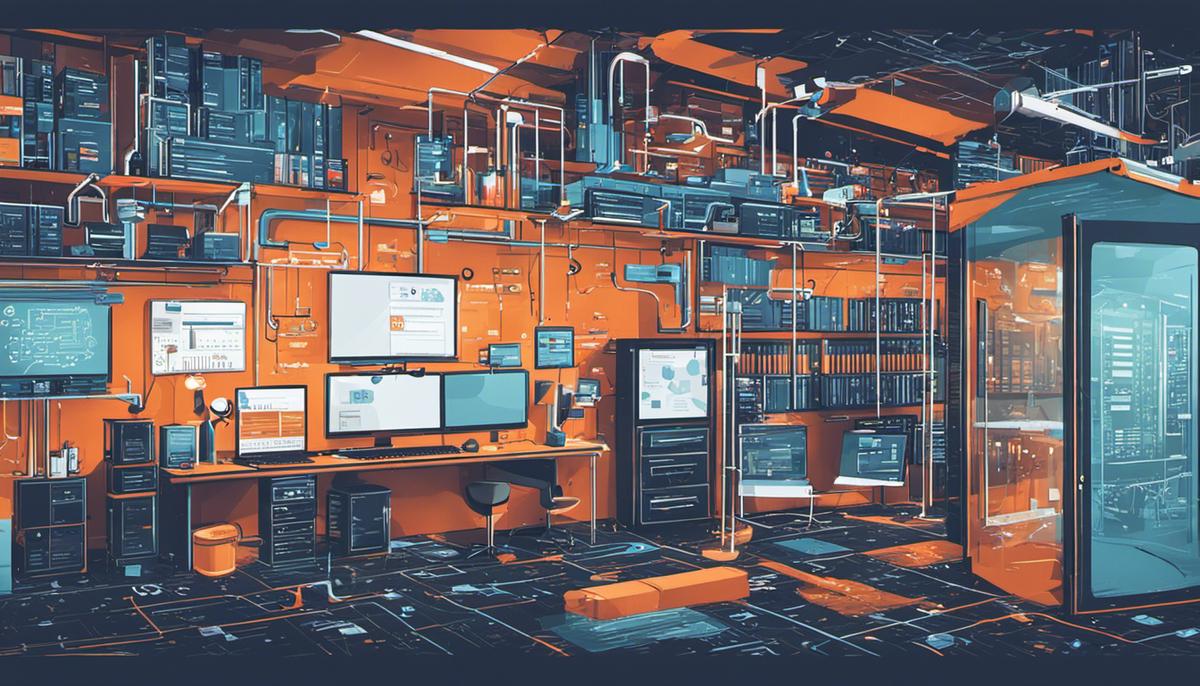In the wake of the digital revolution, the role of entry level data scientists has emerged as a crucial field adjusting the sails of numerous industries. As we further explore the dimensions of this intriguing profession, we ponder on the notable role of an entry level data scientist, the proficient execution of which can set the groundwork for robust progression within the field. We navigate through the intricacies of data collection, cleaning, statistical analysis, predictive modeling, machine learning, and visualization, soaking in the essence of how these elements come together to form a prosperous career. Moreover, spotlighting the indispensable soft skills and technical prowess that potential employers seek brings a surprising heft to our understanding of what it truly means to be a data scientist.
Understanding the Field of Data Scientists
Essential Knowledge and Skills for Entry Level Data Scientists Positions
In this digital era where data has been declared the new gold, a career in data science has become increasingly relevant and desirable. Notwithstanding, aspiring individuals must possess certain foundational knowledge and skills before setting foot in this remarkable field. This article aims to detail the fundamental competencies required to secure an entry-level position in data science.
To begin with, a theoretical understanding of statistics, mathematics, and algorithms is paramount. This includes statistical analyses, hypothesis testing, linear algebra, calculus, probability, and optimization techniques. These concepts form the backbone of many computing algorithms and data analysis techniques used in data science.
Next in line is programming proficiency, specifically in Python or R, the preferred languages in data science. In-depth familiarity with these languages enables individuals to collect, clean, manipulate, visualize, and analyze large datasets to draw insights.
Higher on the complexity scale, machine learning emerges as a vital branch of study. An understanding of fundamental machine learning algorithms – such as linear regression, logistic regression, decision trees, and clustering techniques – facilitates the development of predictive models, key tools in the repertoire of a data scientist.
Data management and manipulation skills are also of great importance. Familiarity with databases (SQL or NoSQL), ETL processes, and tools like Excel, SAS, or SPSS are necessary for manipulating and processing data.
Understanding business intelligence tools like Tableau or Power BI comes as another prerequisite. These tools assist in visualizing complex data in an easily interpreted and accessible format, thereby providing a clear, concise view of the business situation.
Competency in big data platforms, especially Hadoop and Spark, enables the handling of voluminous data in real time. Expertise in these platforms allows vast amounts of data to be stored, processed, and analyzed quickly and efficiently, an increasingly necessary skill in today’s data-driven world.
In addition to these technical skills, one must not neglect the role of soft skills in a data science career. Excellent communication skills, both written and verbal, are essential in presenting complex analysis results to non-technical audiences. Strong problem-solving abilities, curiosity, and creativity foster innovative thinking and the ability to tackle complex challenges head-on.
Last yet equally vital, a demonstrable understanding of the industry or domain wherein one aims to apply their data science skills is critical. This knowledge aids in converting raw data into insightful, actionable results that can effectively address specific business problems.
In a nutshell, breaking into a data science career requires a blend of mathematical knowledge, programming expertise, machine learning comprehension, data manipulation, and communication skills alongside industry-specific insights. These form the fundamental package of skills that can transport an aspiring individual into the dynamic world of data science. Mastering these skills is an iterative process of learning, practicing, and growing, a journey that unfolds in parallel with the evolution of the data science field.
Role and Responsibilities of an Entry Level Data Scientists
Enabling Data-Led Transformation: Entry Level Data Scientists Expansive Roles and Responsibilities
Fostering organizational growth in the contemporary digital era, the role of an entry-level data scientist extends beyond the mere application of technical skills. In an organization or team, their responsibilities are multifaceted, encapsulating a multitude of roles that are fundamental in the transformation of amorphous data into actionable intelligence.
An entry-level data scientist serves as an adept analyst. Deriving insights from data is pivotal for strategic decision-making, hence placing enormous reliance on the data scientist’s crucial role. With their skills in machine learning algorithms and statistical methodologies, they dissect data, scrutinize patterns, and shed light on specific trends or correlations that may contribute to the organization’s overall strategic blueprint.
Data scientists also maneuver as bridge-builders between the technical and business realms. They translate intricate statistical analyses and complex data-driven insights into comprehensible narratives to inform stakeholders proficiently. This remarkable role requires a firm grasp of business intelligence tools, as well as an astute ability to effectively communicate technical concepts to non-technical audiences.
Additionally, data scientists act as invaluable knowledge curators. By judiciously employing big data platforms like Hadoop and Spark, they manage and manipulate stupendous volumes of data with ease. This role necessitates discerning vital information, discarding redundant elements, and structuring the accumulated data, thereby curating a vast repository of knowledge for the organization.
Innovation drivers exemplify another role taken up by entry-level data scientists. With their creativity and problem-solving skills, they utilize data to not only address existing challenges but also to innovate new solutions. They conceptualize prototypes, run tests, refine algorithms, and iterate models to yield better outputs. This intricate role fuels the organization’s quest for innovation and places the data scientist at the heart of impactful breakthroughs.
Being industry-context interpreters, data scientists also apply their industry-specific knowledge to decipher data from an industry-context perspective. This unique lens allows them to comprehend the external business environment, consequently permitting them to make estimations and predictions, and create strategies that edge out competitors.
In the end, the roles of an entry-level data scientist can be regarded as integral cogs in an organizational machine. Although beginning their journey at the entry-level, their contributions span across various functions of the organization, translating data into results, driving innovation, and influencing strategic business decisions.

Tools and Technologies Used by Entry Level Data Scientists
Indeed, data science is a multifaceted discipline that requires an array of tools and technologies for efficient performance. This article will further delve into the digital tools, programming languages, and technologies that are crucial for data scientists.
In the realm of data science, SQL (Structured Query Language) is a vital skill. Despite the rise of many NoSQL databases, SQL remains a steadfast element due to its capacity for handling, managing, and manipulating structured data. SQL is a feature in various traditional and cloud-based databases like MySQL, PostgreSQL, Oracle Database, and Microsoft SQL Server, which are extensively used in the industry.
Further, proficiency in Java or C++ programming languages manifests a significant advantage in certain aspects of data science. Compilers for these languages can handle intensive tasks and can exploit parallelism, therefore managing extensive computational needs optimally. In several instances, particularly in high-performance computing (HPC) scenarios, these skills are exceptionally valuable.
Further to this, a relentless advancement of data visualization tools such as PowerBI, Tableau, and Qlik enables data scientists to represent complex data in a more digestible, visual format. These tools aid extensively in conveying data insights in a manner that stakeholders across all organizational levels can comprehend.
Data scientists also frequently deal with unstructured data, and here, the capacity to utilize Natural Learning Processing (NLP) tools like NLTK, SpaCy and Gensim is invaluable. They help to break down, understand, and derive value from this type of data, which is growing exponentially in the world of Big Data.
In terms of technologies, knowledge of cloud computing platforms like Amazon Web Services (AWS), Microsoft Azure, and Google Cloud is quintessential. These platforms offer scalable and flexible storage and computing power necessary for handling massive datasets commonly encountered in data science.
Containerization tools such as Docker and Kubernetes also have gained traction in the realm of data science. They support seamless and consistent deployment of models across distinct environments, thus ensuring productivity and reducing time-to-market.
Lastly, knowledge of distributed computing frameworks beyond Hadoop and Spark, such as Flink and Storm, are desirable. These frameworks allow data scientists to process and analyze large datasets in a distributed fashion, thereby facilitating efficient data processing and analysis.
In elucidation, a data scientist’s toolbox is constantly evolving and expanding as technology advances. The tools, programming languages, and technologies mentioned above have been widely embraced in the data science community, and mastering them offers data scientists an edge in effectively analyzing data and delivering insightful results.

Pathway to Becoming Entry Level Data Scientists
Successfully transitioning into the role of entry level data scientists necessitates a blend of advanced technical abilities, well-developed soft skills, and a tinge of real-world business acumen, as stated earlier. However, what often goes underacknowledged is the importance of a continued desire and capability to learn, adapt, and innovate in this ever-evolving field.
A critical tool in the standard repertoire of a data scientist is SQL. The 1974-born Structured Query Language remains integral to relational data management even in today’s world dominated by NoSQL databases due to its widely recognized, compact, and reliable data manipulation functionalities. Proficiency in SQL offers an enhanced gateway to extract insight from structured data.
Likewise, familiarity with Java or C++ programming languages can significantly complement one’s Python or R skills. While Python and R remain indispensable with their abundant data-specific libraries, Java and C++ facilitate a deeper understanding of programming architecture and multiple paradigms, which can be especially beneficial in complex system design or efficiency optimization.
Implicit in the expectations of a modern data scientist is the ability to present data understandably and persuasively to the target audience. This is where data visualization tools, such as PowerBI, Tableau, and Qlik, demonstrate their worth. These instruments allow data scientists to generate compelling graphical representations and interactive reports that can effectively bridge the gap between sophisticated technical findings and their comprehension by a non-specialist audience.
As data continues to burgeon in magnitude and heterogeneity, mastery of Natural Language Processing (NLP) tools becomes even more pivotal. Tools such as NLTK, SpaCy, and Gensim allow data scientists to manage and interpret text data, tapping into otherwise missed opportunities for insights derivation.
Beyond managing and analyzing data, a well-rounded data scientist is expected to align with the rising trend of cloud computing. Familiarity with cloud computing platforms, such as Amazon Web Services, Microsoft Azure, and Google Cloud, is crucial, given their widespread popularity owing to their robust, scalable, and cost-effective data storage and computation environments.
Docker and Kubernetes, the containerization tools, have gained momentum due to their undeniable advantages in consistent deployment and scaled orchestration, respectively. These fundamental tools deliver an excellent platform for developing, testing and deploying applications and models, thereby fostering consistency, scalability, and simplicity.
Last but not least, understanding distributed computing frameworks like Apache Flink and Storm is significant for a data scientist to successfully tread the path of real-time analytics due to their exceptional ability to process high-velocity data streams.
In essence, successfully transitioning into an entry-level data scientist requires one to be a technologically-versed scholar, an astute translator of complexities, a potent critical thinker, and an unassailable problem-solver. Yet, the crux of the journey rests upon ardent learning. This field, fundamentally, is an ever-expanding canvas, rewarding those who strive to paint novel insights forevermore.

Future Prospects for Entry Level Data Scientists
As spanned out in the aforementioned discourse pertaining to the entry level data scientist, the career pathway indeed begins with individuals choosing to voyage into pivotal areas of expertise, which not only provides a solid foundation but keeps the creative zeal aflame. This path is shaped through rigorous learning, innovative problem-solving approaches, proficient communication, and team collaboration.
The career journey, enlightened with ingenuity, is paced progressively as an entry level data scientist expands skill set and gains hands-on experience in the field. Fascinatingly, this journey often begins with an entry level position and has the potential to culminate into a data science leader or chief data officer in the organization. Along this path, the individual gains firsthand experience in navigating through raw data streams, translating complex data findings into understandable terms, refining data-driven strategies, developing predictive algorithms, and achieving measurable results.
Beyond the entry level, the next milestone typically lies in the terrain of a senior data scientist. This position requires individuals to delve deeper into analytical techniques and operate in a more autonomous capacity. A senior data scientist is expected to lead project teams, advise on tools and techniques, deliver predictive models, conceive data-partitioning schemes, and engage creatively in problem-solving using the arsenal of advanced analytics.
Further progression occurs as individuals transition into roles such as lead data scientist or data science manager. These roles carry significant responsibility, including forming and overseeing data science teams, designing data models and data collection systems, conducting complex analyses to identify trends and opportunities, and guiding the strategic direction of projects. At this phase, a strong command of leadership skills is as necessary as technical proficiency, underscoring the significance of both hard and soft skills in the journey of a data scientist.
Eventually, demonstrating technical leadership, strategic thinking, and a proven record of delivering results, an individual may climb the apex to become the chief data officer. These roles carry the pinnacle responsibility of overall data strategy, governance, control, policy development, and effectiveness of data use in the organization. This requires a dexterous blend of expert technical knowledge and a keen understanding of how data drives business operations and impacts strategic objectives.
Undoubtedly, the journey from entry level data scientists to a leading role is not a direct line and may meander based on industry trends, sector-specific demands, and the changing landscape of data science itself. However, the core ingredients remain consistent: a robust foundation in key technical skills, an insatiable curiosity, a problem-solving mindset, excellent communication skills, and, above all, the audacity to innovate and explore uncharted territories.
The adventure of a data science career is paved with discoveries at every turn, charting a path from entry level data scientists to influential data leaders shaping the strategies of tomorrow. The vast expanse of this journey is rich with opportunities for those ready to step forth and unlock the formidable power of data. Indeed, the metamorphosis of an entry level data scientist to the zenith justifies the quote, “Data is the new oil.”

Truly, the future for entry level data scientists holds immense promise, as the field promises continual expansion and diversification. The expertise rarefied through robust foundational experiences can thus pave the way for further advancements in technical knowledge leadership roles or even allow one to carve out a specialized niche within the vast realm of data science. With a clear view of the pathway leading to an entry level position, prospective data scientists can thus align their ambitions in conjunction with the trends dictating the field, empowering themselves to thrive in the dynamic data-driven landscape that lies ahead.

